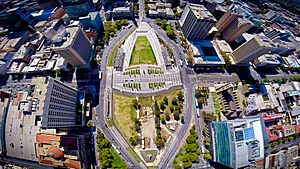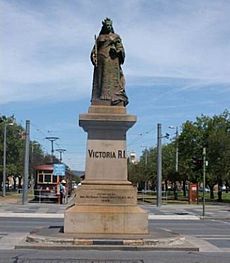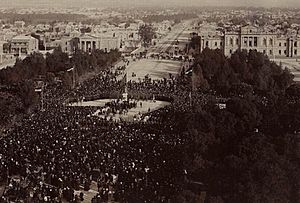Victoria Square, Adelaide facts for kids
Quick facts for kids Victoria Square |
|
|---|---|
| Tarntanyangga | |

Aerial view of Victoria Square
|
|
| Lua error in Module:Location_map at line 420: attempt to index field 'wikibase' (a nil value). | |
| Type | Square |
| Location | Adelaide, South Australia, Australia |
| Area | 2.4 hectares (5.9 acres) |
| Created | 1837 |
Victoria Square, also known as Tarntanyangga, is a large public space in the middle of Adelaide, South Australia. It is one of six main squares that were planned for the city.
Colonel William Light, who designed the city of Adelaide in 1837, included this square in his plans. It was named on May 23, 1837, after Princess Victoria, who was next in line to become the Queen of Britain. In 2003, the square was also given a second name, Tarntanyangga. This name comes from the Kaurna language, spoken by the original Aboriginal people of the area.
Victoria Square has been updated and changed many times over the years. During the Christmas season, a very tall Christmas tree is usually put up in the northern part of the square.
Contents
Understanding Victoria Square's Dual Name
The square was first named "Victoria Square" in 1837 to honor Princess Victoria.
To show respect for the traditional owners of the land, the Adelaide City Council started using a dual name for the square in 2002: Victoria Square/Tarndanyangga. By 2013, this was updated to Victoria Square/Tarntanyangga.
The Kaurna word "Tarndanya" means "red kangaroo rock." This was the name the Kaurna people used for the area where South Adelaide is now. The Kaurna word tarnta (or tarnda) means "red kangaroo," and kanya means "rock." The ending "-ngga" shows it's a place, meaning "in, at, or on." This suggests there were rock formations in the area that looked like red kangaroos or were important for them.
Victoria Square/Tarntanyangga is still a very important meeting place for Aboriginal people. Many events and gatherings for Indigenous communities happen here. For example, the National Sorry Day is held here every year on May 26. Also, during NAIDOC Week in July, there's a fun family day and a march to Parliament House.
The Australian Aboriginal Flag was first flown in Victoria Square on July 9, 1971, during a land rights rally. Since July 8, 2002, the Adelaide City Council has allowed the flag to fly permanently next to the Australian flag in the square.
What You'll Find in Victoria Square
Victoria Square is right in the middle of Adelaide's city plan, which was designed by William Light. Many important buildings are located around the square.
On the north and south sides, you'll find courts like the Supreme Court of South Australia and the Magistrates' Court. There's also the old Treasury building, which is now a hotel.
On the east side, you can see the beautiful Catholic Cathedral. There are also government offices, including the Premier's office, and the Torrens Building, which houses Carnegie Mellon University.
The west side of the square has more businesses. This includes an entrance to the Adelaide Central Market, a Hilton hotel, and offices for different companies.
King William Street, a major road, runs right through the middle of the square from north to south. This creates a diamond shape in the square. Another road connects Wakefield Street (from the east) to Grote Street (to the west), cutting across the square.
A tram stop for the Glenelg tram line is located just south of the Queen Victoria statue. It was moved to the western edge of the square in 2007 when the tram line was extended.
A Look Back at Victoria Square's History
The connection between Aboriginal people and this square goes back many centuries. The Kaurna people gathered here for special ceremonies and dances. The area was a central camp for thousands of people. In the 1960s, Aboriginal communities started using Victoria Square again as a gathering point.
19th Century Changes
In 1837, Colonel William Light planned the city of Adelaide, including a central square for public use. He first called it "The Great Square," but it was later named after Princess Victoria.
For many years, the square was just a dusty, empty field. In 1854, the Adelaide City Council started planting trees and building paths. They also put up a wooden fence. Later, an east-west road was built, dividing the square into two garden areas. By 1883, King William Street was extended through the square, dividing it into four garden sections. The wooden fence was replaced with fancy iron railings. A statue of Queen Victoria was placed in the center of the square in 1894.
20th Century Developments
A statue of Colonel Light, now called Light's Vision, was first placed at the northern end of Victoria Square in 1906. It was later moved to Montefiore Hill in 1938.
The tram stop in the square was moved in 1966 to a more central location. In 1967, the square was redesigned into its current diamond shape. The Three Rivers Fountain, created by John Dowie, was built to celebrate the visit of Queen Elizabeth II and Prince Philip in 1968. This fountain represents three important South Australian rivers: the Murray, Onkaparinga, and Torrens.
On July 12, 1971, the Aboriginal flag, designed by Harold Thomas, was flown for the very first time in Victoria Square. Today, it flies permanently next to the Australian flag in the square.
21st Century Upgrades
In 2002, the Adelaide City Council officially recognized the square's heritage by giving it the dual name Victoria Square/Tarndanyangga. In 2012, the council approved $24 million to update Victoria Square. The first part of this project was finished in 2014. The full plan included:
- Moving the Queen Victoria statue slightly north.
- Adding new art.
- Moving the tram line.
- Creating new garden areas and an event lawn.
- Building new public toilets and a cafe.
- Relocating the Three Rivers Fountain to the south.
Key Features of Victoria Square
Queen Victoria Statue
In the middle of the square is a statue honoring Queen Victoria. It was made from a design by C. B. Birch and was unveiled in 1894. The statue was a gift to the city. It was moved and cleaned in 2013 as part of the square's upgrade and returned to a slightly different spot in December 2013.
Three Rivers Fountain
The Three Rivers Fountain was built to remember the visit of Queen Elizabeth II to Adelaide in 1963. It was first turned on by the Duke of Edinburgh in 1968. It was later moved to the southern end of the square and reopened in 2014.
The fountain, sculpted by John Dowie, has a crown shape in the center to represent the royal visit. The fountain's figures represent the three rivers that supply Adelaide with water:
- The Murray, shown by an Aboriginal man and an ibis.
- The Torrens, shown by a woman and a black swan.
- The Onkaparinga, shown by a woman and a heron.
This fountain was recognized as an important heritage site in 2012.
The State Survey Mark
At the northern end of the square, you'll find the State Survey Mark. This marks the spot where Colonel Light placed the first peg (a small stake) for surveying the city of Adelaide on January 11, 1837. This mark is the starting point for all other survey measurements in South Australia.
Reconciliation Plaza
The road that connects Grote and Wakefield Streets was named Reconciliation Plaza in 2013. This plaza has two flagpoles, flying the Australian National Flag and the Aboriginal Flag. The Aboriginal Flag has flown permanently in the square since 2002. In 1971, Victoria Square was the first place the Aboriginal Flag was ever flown, during a land rights rally.
Reconciliation Plaza was officially opened on May 26, 2014.
Statue of Charles Kingston
A statue of Charles Kingston stands in the square. He was a Premier of South Australia from 1893 to 1899. The statue was created by British sculptor Alfred Drury and was unveiled on May 26, 1916. Kingston helped bring about important changes, such as giving women the right to vote in Australia and creating new laws for workers.
Gallery
See also
 In Spanish: Plaza Victoria (Adelaida) para niños
In Spanish: Plaza Victoria (Adelaida) para niños












